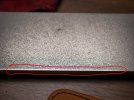Well, if you have some way of sharpening the last 1/4" with a stone or plate without using the extreme edge of the stone or plate, I'm all ears.
As far as tools, I just remembered that I have diamond triangular sticks for the Sharp Maker I never use anymore which will be perfect for this task.
Why wouldn't you use the whole stone? How do you expect to get to the inner joint of the edge and racisso without starting at the edge of the stone? You don't need to use any more pressure, and it won't hurt the stone unless you are being too aggressive. I have DMT stones that are 10 years old and have sharpened truck loads of knives, especially very hard steel Spyderco's and my plates have aged like a fine leather coat. Same for oil stones or waterstones, you need to use the stone for all that it is worth but you also need to put pressure on the knife in all the correct places.
When I teach someone to sharpen I ask that they imagine things differently, to look at sharpening from a different perspective. You are not holding an angle and you are not slicing from the stones, you are holding two flat surfaces together and keeping a bond with pressure.
First you must understand that the bevel and the stone are just two flat surfaces and we want to keep these surfaces in as flat of contact as possible at all times, and with all points of the blade. Now on to the real important part, the pressure one usually applies to a knife in sharpening is equal to the way someone holds a hammer to drive a nail, while often using the free hand as a guide pushing from the spine. Pinch the handle between the middle finger and thumb like a machete while leaving the index finger free. I tend to move my thumb to the spine for more control (like a thumb forward grip) and as the edge is making contact with the stone the index finger is used to put pressure on the lowest section of the racisso. You want to push to the earth with your index finger at all times, this is what holds two flat surfaces together or for most.. this is how to control the edge angle. Thumb on spine is forward movement, up and down vertical movement of the handle is to follow the curve and lastly, the freehand is used to apply additional edge pressure and grinding control. That, is sharpening in a nutshell.
In your case and for most that sharpen a Spyderco they are not use to the constant curve of the Spyderco profile. The natural tendency most have is to sharpen as if the blade has a flat section before the belly but this is not the case with Spyderco and it tends to lead to an area of about 1/4-1/2 in. that is untouched at the back of the blade. Finger placement from the freehand needs to be all the way back at the racisso while the main control hand is lowering the handle far enough so the edge is making starting contact all the way in that corner, index finger pressure is also important here.
The sharpener needs to imagine the contact point on the stone is only 1mm wide, you only sharpen 1mm at a time. When you think of it like this you learn to control where you sharpen.

